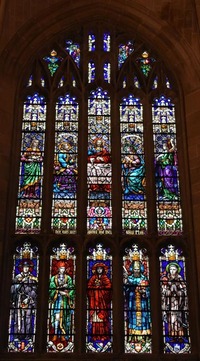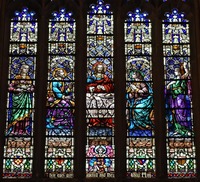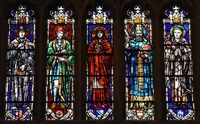Window
Building Name: Cathedral of the Most Blessed SacramentStudio Name: Willet Hauser Architectural Glass
City: Detroit
Window Shape: 6 (gothic arched, more than 2 vertical sections)
Subject/Title of Window: The Supper at Emmaus
Brief Description of Subject:
The canopy topping this five panel window is decorative in nature highlighted by angels with censers.
The scene below is topped with decorative inscriptions from the Vulgate -- the first two panels from Matt 28:4-5, the middle panel from Luke 2:14, was not able to identify the last two. The "Guide to the Cathedral of the Most Blessed Sacrament" gives an excellent description of this scene which is covered in Luke 24:13-24 (see last paragraph). Just a comment. There are inscriptions above the disciples --- "Ex Dono Deo" by the gift of God and "Cruce Salus" from the Cross comes salvation. Below the scene are decorative coats-of-arms as befitting a Norman styled church and an angel holding a cross.
In the lower portion of this window is found five saints with the artist's creation of their coats-of-arms.
St. Stephen of Muret (1045 - 1124) was born into nobility and wealth but when he had a vision of the trinity he converted to Christianity and vowed "I, Stephan, GIVE THYSELF to God the Father, God the Son, and God the Holy Spirit." St. Stephan then gave up all his possessions except a RING which he wore as a reminder of the vow to serve God. He spent the rest of his life as a hermit and built a hermitage at Muret. He attracted many followers and founded what is now called the "Order of Grandmont", becoming its first abbot. His attributes seen here include dressed as an abbot, holding a banner with the words "Give Thyself", left hand dumping jewelry from a jewel box (giving up his wealth), wearing a ring on a finger of his right hand, and in his coat-of-arms three crosses and a descending dove (Holy Spirit).
St Justin Martyr (2nd Century) was a Roman philosopher who converted to Christianity and wrote very important works on Christian philosophy. His most important works include two Apologies (defenses of Christianity) both addressed to the Roman Senate, and the "Dialogue with Trypho". Trypho was Jewish and the "Dialogue" explained how the Old Testament prophecies proved Christ is the Messiah that the Jews had been waiting for. When Roman persecution of Christians started up,he was denounced and after a trial was scourged and then beheaded for his Faith. His attributes seen here include dressed as a Roman, wearing a cross pendant, pointing to a book of the Gospels, and in his coat-of-arms a crown of thorns and nails (instruments of the Passion).
St. Charles Borromeo (1538 - 1584) was a major figure in the Counter Reformation. He was born into an aristocratic family and at age 12 decided to devote himself to the Church. He went to Rome at the request of his uncle Pope Pius IV to work for the Vatican. He later became a priest, then the Bishop of Milan, and eventually a Cardinal. He fought against corruption within the Church. He had a famous encounter with corrupt canons; when he went to their monastery he held a CROSS IN HIS HANDS and the canons shot the cross. St. Borromeo founded a Confraternity called the "Prescatori" (fisherman) as they FISHed for souls. His attributes as seen here include costumed in a Cardinal's cape and hat, holding a cross in his hands, and in his coat-of-arms a fish and a cross.
St. Chrysostom ( c. 349 - 407) was the Bishop of Constantinople and is a Doctor of the Church. He is best known as a great teacher and preacher of the Bible as well as a prolific writer -- especially of the Gospels. Attributes seen here include costumed as a bishop, a quill pen (writer), the Book of Gospels, and in his coat-of-arms an open book and 3 oil lamps (wisdom).
St. Simon Stock (c.1165 - 1265) joined the Carmelite Order, becoming a prior general and founding many Carmelite communities. He is best known from an apparition of the Virgin Mary in which she gave him the "Brown Scapular" as well as the brown habit that the Carmelites now wear. Attributes seen here include costumed in the Carmelite brown habit, hand of the Virgin Mary giving a scapular to Simon Stock, and in his coat-of-arms a cross and an unknown object. The Carmelites actually have a coat-of-arms and it has an image of a cross atop Mt. Carmel -- that cross represents our salvation through Jesus.
From the Guide to the Cathedral of the Most Blessed Sacrament, Copyright 1958, Archdiocese of Detroit.
On the afternoon of Christ’s Resurrection, two of His disciples, dejected because they thought their Messias had been a failure, were on their way from Jerusalem to Emmaus. A stranger joined them on the road and began to explain the Scriptures to them. That evening as they supped with their companion, they finally recognized him to be their Master “in the breaking of the bread.” The center panel shows Christ and on either side the disciples who had journeyed with Him. In the outer panels are serving maids who attended the table that evening. In the lower windows are St. Stephen of Myret, St. Justin, St. Charles Borromeo, St. John Chrysostom, and St. Simon Stock.
Inscriptions: Their eyes were opened and they knew Him
The MSGC is a constantly evolving database. Not all the data that has been collected by volunteers has been sorted and entered. Not every building has been completely documented.
All images in the Index are either born-digital photographs of windows or buildings or are scans of slides, prints, or other published sources. These images have been provided by volunteers and the quality of the material varies widely.
If you have any questions, additions or corrections, or think you can provide better images and are willing to share them, please contact donald20@msu.edu





